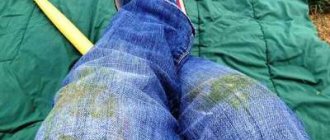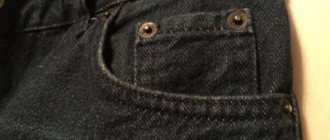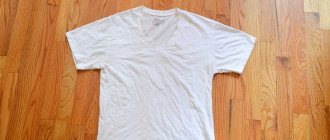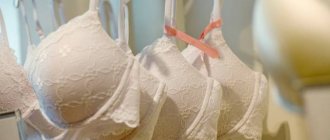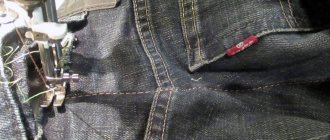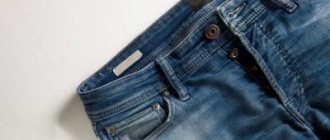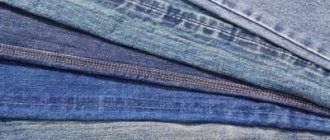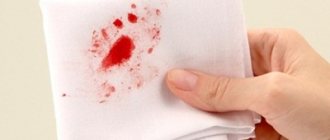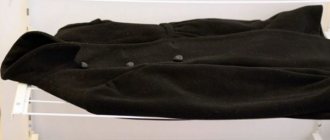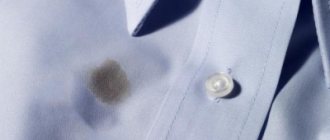Jeans are a practical type of clothing that is always relevant. The variety of styles and branded models in various colors amazes with its spectacular appearance. Products in light colors never go out of fashion; they can be bought in any store. And knowing how to whiten jeans at home, you can transform old dark-colored models into fashionable exclusive items, as well as hide stains in prominent places. Strict adherence to the rules, as well as knowledge of safety precautions, will help you bleach your jeans efficiently without harming the material.
Features of denim
Before you start updating your denim wardrobe, carefully study the fabric you will be working with:
- If the item is new and for some reason you decide to modify it with color. Then you can safely dye the fabric in any convenient way, since the weave of the threads is dense and there are no thinned or worn areas yet.
- The item will be reused. In this case, carefully inspect the fabric, marking all abrasions, defects and damage. The lightening process destroys the structure of the threads; in these places the item will be especially prone to tears. Skip these areas when painting. Alternatively, decorate them with additional pieces of fabric, braid, ribbons or threads.
- Pay attention to the denim density. When the material is thin and light, it is more quickly saturated with the coloring composition. The thicker the fabric, the worse the pigmented product penetrates, the more uneven the result will be.
- The abundance of details, pockets, seams, rivets, inserts, flounces and folds make the whitening process difficult. Such textures are good for obtaining stains, patterns and gradients rather than for uniform shade of boiled denim.
Before you start bleaching, carefully examine the fabric you will be working with. Pay attention to the density of the fabric, the presence of details, pockets, folds.
Blue for jeans
The simple and affordable composition is ideal for restoring the color of classic denim items. The drug is available for purchase in hardware stores. Please read the instructions carefully before use.
Please note that the substance is suitable for tinting blue items. It will not be possible to completely change the shade with this help. The durability of the bluing is not high, so after a while you will have to repeat the procedure.
Another point that cannot be neglected is that during the washing process after dyeing, the pigments from the fabric will be washed out, so it is better to wash the item separately from others or with clothes of the same color.
Is it possible to bleach jeans?
Denim differs from other materials in its color instability. It automatically loses color saturation with each wash. The material is paintable. But to get a beautiful result, you will need some skill and knowledge of how to lighten jeans.
To get the desired result, skill and knowledge of the basic rules for lightening denim are important.
The bleaching procedure is suitable for all types and shades of denim. You can whiten the surface of the fabric so that the brightener does not penetrate deep into the structure of the threads. Or you can bleach it in such a way that the fabric in this place becomes thinner and even breaks. This way you can simulate the “flaw” effect.
Using the lightening procedure, you can achieve a “flawed” effect on jeans.
The higher quality the denim, the more aggressive bleaching agents it can withstand. Domestos or long-term digestion are suitable for such material. If you are not sure of the quality of the fabric or it is thin and easily torn, limit yourself to using soda or hydrogen peroxide. These are more gentle options that do not destroy the structure of the threads so much.
High-quality, strong denim can withstand the most aggressive bleaches.
Whitening rules
A few facts about bleaching denim pants:
- jeans in dark shades can be lightened, but they will not become completely white;
- the darker the initial shade, the darker the result will be;
- White color can be given to blue jeans;
- It is not recommended to bleach colored jeans, since the dyes used for them react differently to bleaching agents;
- It is much more difficult to lighten jeans completely than to do it in spots, such as “varenka”.
Do not immediately take the item that you want to give a second life, carry out a trial procedure using unnecessary material, this will help identify errors and not spoil the jeans.
How to do lightening
You can lighten an item in various ways. Classic denim is the ideal base. Its blue, cyan or cornflower blue shades are most susceptible to a uniform loss of color intensity. Be prepared for the fact that the final result is difficult to predict. Each thing will “react” differently.
There is no need to be upset if expectations differ from reality. The fabric can be additionally painted with paints, modified with brightener, or decorated to your taste.
Carefully study all the options for how to whiten jeans. Each method has its own effect. For example, bleach or bleach whitens much stronger and more aggressively than citric acid. In the first case, the shade of the fabric will be lighter and cleaner than in the second.
Before work, test the reaction to the bleach on a small, inconspicuous area of the item. If you are satisfied with the result, proceed with the transformation. If the color is not saturated enough, increase the time the fabric is kept in the solution or change the lightening method.
If you don't get exactly the result you expected, don't be upset. You can always complement the design with paints, accessories or other effects.
If you do not boil the item, but manually create bleached areas, make sure that the bleached spots do not appear on the other side, for example, on the front and back of the trouser leg. Unless, of course, you are pursuing such a goal.
To do this, create separation layers between sections of foil or thick paper. This way, the denim will not be soaked through with the brightening agent and will not create unplanned patterns. In this case, the intermediate layer is removed only after the item has completely dried.
Dyeing clothes at a dry cleaner
If you want to restore the color of something dear to you or are not sure that you can cope with the task yourself, you can always turn to the services of professionals. This option has a number of advantages:
- Masters guarantee high-quality results.
- You can perform detailed color restoration in individual areas.
- Specialists will be able to radically change the color of the product and create a new shade.
- The salon has a wide selection of paints.
- Experienced craftsmen are familiar with the nuances of the textile industry, as well as the variety and properties of dyes. They have high-tech equipment and use advanced techniques. You will be warned about possible risks and the specifics of the work will be agreed upon.
- In addition, there are advantages in that you do not need to waste your time and effort working with the material. There is also no need to wash the surfaces of household items from the dye. Also in this case there will be no problems with finding a dye and selecting a shade.
Selection of special means
So, you have chosen an item to bleach. There are several ways to quickly lighten:
- The washing machine automatically lightens things by several tones. To do this, add 2-3 tablespoons of pharmaceutical hydrogen peroxide before washing, along with the usual dose of washing powder. The quick and easy method has one drawback: you cannot control all stages of coloring and vary the intensity. The result is unpredictable, but effective.
- Soaking an item in a lightening solution changes the shade by half a tone. This is a gentle method for light, summer fabrics. If the denim material is not bleached enough for your taste, the procedure can be repeated several times until the desired result is achieved.
- Boiling is the most effective way to lighten dense fabrics. The result exceeds all expectations; the material can acquire all shades of white and pale blue. It is necessary to follow the rules of personal safety and spend a little time. And you need special dishes in which food is not cooked.
- The most creative and unpredictable lightening process is done by hand. It is suitable for thin, easily torn items. Using available materials, you can achieve amazing results and bring bold design solutions to life.
The process of bleaching in a washing machine will make it possible to lighten jeans by two or three tones.
But for washing you need to add hydrogen peroxide. When you have decided on a method for bleaching jeans at home, it’s time to familiarize yourself with the variety of methods. Each of them has advantages. And the process is fun and exciting. Sometimes a special product can even be found in the refrigerator. For whitening the following will come to the rescue:
- white;
- hydrogen peroxide;
- lemon or citric acid;
- soda;
- "Domestos" or other cleaning product of similar effect;
- hydroperit.
In order to whiten jeans, many methods and various means are used.
Folk remedies for whitening jeans
Folk remedies for how to lighten jeans at home are equally good in that they are effective with little investment of money and time. This is an ideal option for a spontaneous decision to update things. For example, there is a party planned in the evening or you immediately want a new item in your wardrobe.
Hydrogen peroxide
Hydrogen peroxide can be found in your home medicine cabinet. It is safe to use and creates lightened patterns or streaks with gradient stretching in several tones. The product can be added during washing, then the coloring will be uniform. In addition to whitening, the product eliminates the yellowness of denim that appears over time from long-term storage or constant wear.
Whitening with hydrogen peroxide is one of the most popular and cheapest methods.
Add 3 tablespoons of peroxide to a small bowl of warm water. Adjust the exposure time yourself. Observe the process and soak the jeans until the desired shade is obtained.
You should remember that hydrogen peroxide is highly flammable. Carry out all procedures for updating things away from fire or a switched on stove. Wear safety glasses and do not bend too low over the bowl of solution. If peroxide gets into your eyes, rinse with running water for a quarter of an hour and consult a doctor immediately.
Don't forget about safety precautions when whitening jeans using hydrogen peroxide.
Soda
Baking soda has long been a favorite among home denim designers. You can make your jeans a little lighter at one time, or you can whiten them over and over again, transforming them after each wash.
Before plunging into the basin, turn your jeans inside out. This will help maintain the quality and structure of the threads.
To prepare a soda solution, mix 100 grams of soda and 80 grams of washing powder in a bowl of hot water. Wait for the mixture to cool to room temperature, then place the jeans for an hour and a half.
To preserve the quality and structure of the threads as much as possible, it is recommended to turn the item inside out before immersing it in the basin. Then rinse your jeans in warm water, straighten them to dry, and enjoy the new addition to your wardrobe. This procedure can be repeated regularly, constantly lightening the item by half a tone.
There is a second method of bleaching jeans with soda, which helps to achieve a uniform, beautiful, whitened color:
- Mix baking soda and washing powder in a 1:2 ratio in a bowl of warm water.
- Soak the item in half of this solution for half an hour.
- Wash the jeans by hand by adding the second part of the soda and powder solution to the washing water.
- Rinse the jeans well and dry.
Baking soda will help whiten denim in a few washes.
Domestos
A great way to lighten and bleach your jeans is to use kitchen and plumbing cleaners. This may not only be Domestos. “Toilet duckling”, “Gala” and others are suitable. To create a concentrate for 3 liters of water, use 100 ml of cleaning product. Stir thoroughly and submerge the jeans in the liquid.
There is no recommended time for exposure; you need to control the process of lightening the fabric yourself. Once you are satisfied with the result, the procedure can be completed. Jeans should be washed well and rinsed in running water. If you do not remove the cleaning chemicals from the fibers of the material, there is a risk of an allergic reaction on the skin.
Not only Domestos is suitable for lightening denim. You can use “Toilet duckling”, “Gala” and other means.
White
A strong and effective product can be used in two ways: when washing jeans or boiling them. Whiteness has such a destructive effect on fabric that thin threads can simply dissolve.
Washing is a more gentle procedure for items. This is suitable for light fabrics, for summer, loose denim trousers. To do this, dilute 100 ml of white in a 10-liter bowl of water and stir thoroughly. Immerse the jeans in the solution for half an hour. All that remains is to wash the item with universal powder and dry it.
When covering fabric with “Whiteness” you can use two methods – washing and boiling.
Lemon acid
Citric acid is closer to natural dyes. It does not spoil the quality of the fabric or thin the material, as chemical reagents do. You can discolor jeans with either lemon or citric acid:
- If using lemon, squeeze 10 tablespoons of the juice into a bowl of warm water.
- For the same volume, take 10 teaspoons of citric acid.
- Thoroughly stir lemon or citric acid in water, immerse jeans for 4-5 hours.
- Rinse and dry.
This procedure takes a lot of time. But the quality of the item is preserved, the material does not deform or become thinner.
Bleaching with citric acid takes a long time, but does not spoil the quality of the fabric.
Hydroperite tablets
Hydroperite tablets are comparable to bleaching with hydrogen peroxide. The product lightens jeans by half a tone and protects the fabric structure. Hydroperite is added during washing along with washing powder. This condition is enough to quickly and evenly whiten the item. Crush 3-4 tablets and be sure to rinse the item thoroughly.
Hydroperite is added during washing and lightens the fabric by half a tone. If you need to lighten it more strongly, you will have to wash it several times.
Ways to use powder dyes
Jeans dyeing includes both machine dyeing and manual color changing. Let's look at the options in more detail.
Machine dyeing
- To ensure that your pants do not become spotty, but acquire a uniform, even tone, first dissolve the dye as indicated on the label. If there is no information, then dilute the standard sachet in 0.5 liters of water. During the process, make sure that all the powder is dissolved, because lumps and grains of sand can ruin the job.
- Place the prepared solution in the drum of the washing machine. If the label on your item says that you should add salt or soda, then add the same ingredients to the drum.
- Load the item you are going to revive into the machine. For cotton or linen, set the temperature to 95 degrees.
- As for time, it is better to choose the longest period. After the machine finishes working, take out the pants and place them in the basin. First, place vinegar diluted with water in a basin at the rate of 1 tbsp. vinegar per 1 liter. liquids.
- Let the trousers soak in this solution for 25 minutes. After that, wash them in the machine in the usual way for jeans: a minimum period of time, and a temperature of no more than 40 degrees.
- Upon completion of all manipulations, your trousers will acquire the desired shade.
Dyeing in an enamel vessel
- Dilute the coloring powder in a liter of hot water. Carefully review the packaging; if it indicates that you need to add soda or salt to the composition, then add the required amount. Stir until completely dissolved.
- Pour the resulting solution into an enamel container. Add 5-7 liters of water there. Place the pants you want to dye in this bowl.
- Move the basin to the fire and “cook” them at a temperature of about 95 degrees for about 60 minutes. Systematically stir the contents of the basin with tongs or a stick.
- As soon as the “cooking” period is over, remove the trousers from the solution, cool, and rinse them first in warm water and then in cold water.
- Soak clean pants for half an hour in a vinegar solution, and then wash them by hand using washing powder.
Now you know how to dye old jeans to refresh your favorite item and get a fashionable new addition to your wardrobe.
Important! If you have used a washing machine, do not wash white items in it immediately after the dyeing procedure. It is better to let the equipment run idle for a session to whiten the drum a little.
Lightening process
The dynamics of fabric lightening directly depends on how well it was saturated with the bleaching solution and how long this process lasted. If you regulate the access of reagents to certain areas of the tissue, you can obtain original patterns and stains.
Slight brightening effect
You can create partial lightening on an item without completely immersing it in liquid with bleach. For example, you plan to lighten the bottom of your skirt and get an ombre effect. Immerse the product in the diluted composition to the painting height. In order not to keep the item hanging, secure it on a stick or on a hanger. This way you will get a uniform blurred edge using the ombre technique.
The longer you leave the item in the solution, the more the colors will fade. Adjust the intensity of the dyeing process and remember that dried fabric will look lighter than wet fabric.
The effect of lightened stains
Beautiful lightened stains are obtained if you first twist the jeans tightly and secure them in this position with elastic bands. The bleaching liquid will penetrate unevenly into the structure of the fabric and will brighten the areas of the fabric that are “outside” more strongly. The material inside the resulting folds will be least susceptible to staining.
After washing and drying, beautiful horizontal stains with smooth, blurred boundaries are obtained on the fabric. To whiten vertical stripes, securely hold the jeans in certain areas with clothespins or paper clips.
Bleaching threads on pants
If you have jeans with a ripped effect and multiple horizontal threads, you can only dye them. It will look original and attract the attention of others. To prevent the fabric from staining on the back side of the item, place a protective layer of foil or other dense material inside the item. Blot the threads with bleach, leave for the required period of time, rinse and dry.
On torn pants, only horizontal threads can be lightened. It will turn out original and impressive.
Complete whitening
To achieve complete bleaching, maximum lightening of the item, boiling or very long soaking will help. The stronger the effect of the coloring composition, the more the structure of the thread is destroyed. The lighter the item, the easier it is to achieve maximum lightness.
You can get strong whitening results by boiling or soaking for a long time.
Fringe bleaching
It is better to bleach individual threads, such as fringe, by hand. This makes it more convenient to control the color change process. Cover the areas you don't plan to paint with tape. Blot the threads with the prepared solution using a kitchen sponge. Or spray from a spray bottle.
When the threads change color to the desired color, rinse the area of fabric in cool water, peel off the tape and dry.
It is better to bleach fringe on jeans or denim shorts by hand.
Creating drawings or patterns
Beautiful patterns are created using improvised means:
- If the fabric is pinched with clothespins or bobby pins before bleaching, the result is pointed stars.
- For blurry circles, pull part of the fabric with rubber bands or strong threads.
- Citric acid and stencils create original patterns on fabric, even if you don’t know how to draw professionally.
- A spray bottle or sprinkler will create beautiful drops, drips and splashes.
If you decide to decorate your jeans with patterns, you can get an excellent result using a stencil and citric acid.
Turn on your imagination
But what if you want to get an original product that no one else has? Try one of the following methods.
- To create a design, apply the composition with a brush. For example, paint the middle, leaving the side lines untouched.
- The stripes are formed very simply. During the bleaching process, the jeans are rolled and stapled. If the twist is weak, the streaks will be thin. And by twisting it, as if you were wrung out a towel, you will get wide streaks. There is one more point here. If you fold the item lengthwise, you will get vertical streaks. And if across - horizontal. It is almost impossible to predict what they will be like.
- If you attach stars or other figures to fabric, then after bleaching their outlines will appear as if drawn.
- Gradient. This is complete freedom of action. You will need several bleach solutions of varying concentrations. Using a sponge, apply different solutions to the fabric in a random or planned order.
- You can paint a denim jacket in the same way, not just by lightening it, but by applying an intricate pattern.
- By spraying bleach from a spray bottle, you can get a very interesting print.
Want trendy jeans? All in your hands. Home whitening will allow you to create a unique, creative model that no one else has. And these same methods will restore the shine to stained or grayed white jeans.
How to boil jeans
The process of boiling in white is the most labor-intensive, but effective:
- Wear rubber gloves and, if possible, safety glasses.
- Use a metal bucket or pan.
- For occasional stirring, use a wooden stick or spatula.
- Fill the container halfway with water so that the boiling liquid does not spill out or splash.
- Immerse clean and dry jeans in the boiling solution.
- Make sure that the item does not float during bleaching.
- The first fabric lightening effect will appear within 10 minutes.
- It is recommended to “cook” jeans for no more than half an hour, otherwise the whiteness will begin to destroy the structure of the threads.
- After boiling, wash and rinse the jeans well.
- The final result of digestion will be visible on the dried fabric.
When boiling denim, you can get an unexpected and very original result.
Acrylic paints
You can paint jeans with acrylic paints at home. They do not wash off and are very durable. Apply to the product with a brush, drawing the selected design.
Painting jeans with acrylic:
- Wash the item, dry it and iron it well.
- Smooth or stretch the area where you will apply the paint.
- Place cardboard in the pant leg to avoid staining the back side.
- The paint is applied in a thin layer so that the design lasts longer. You can buy stencils or make them yourself, this makes it easier to apply the product.
- After finishing painting, you must leave the product in its original condition so that it dries well. This will take 15 hours.
It is not advisable to machine wash decorated jeans. In order for the product to preserve the design longer, it must be washed at a temperature of 30–40 C, by hand.
How not to spoil something
- Always test the bleach liquid on a small area of the fabric. Evaluate the result, check the quality of the threads after dyeing.
- If you are creating original patterns, do not use metal clamps to avoid rust stains.
- Do not exceed the permissible concentration of whiteness and the time the fabric remains in the solution. This destroys the fibers of the fabric, and there is a risk of ruining the item forever.
- If you use a lace to tie fabric, take a white one so that it does not bleed its dye onto your jeans.
- Do not boil items made from thin stretch fabric.
- Follow safety precautions! Remember, you are working with liquids that can cause injury and burns.
The whitening process is fascinating and gives free rein to your imagination. An ordinary, boring, boring thing can sparkle with new colors. It’s especially nice that whitening is inexpensive and easy to perform. Update to your heart's content!
Safety
When working with aggressive bleaching agents, you first need to think about safety. To do this, follow a few rules:
- First of all, you need to find a suitable place. A bath is perfect for the whitening procedure;
- Protect your hands with rubber gloves; contact with chlorine on your skin can cause burns;
- the bleaching room must be ventilated, otherwise there is a risk of poisoning from toxic fumes;
- Avoid getting the product into your eyes; if this happens, rinse them well with running water;
- If you get it in your throat, rinse it with boiled water;
